Use your photos or public domain photos for reference.
How To Paint A Giraffe
This acrylic painting tutorial will show the beginner painter how to paint a giraffe on an 11″ x 14″ canvas. The style of this giraffe is “loose”, non-realism and cartoon-like!

Included in this tutorial is a free traceable of the giraffe so you don’t have to draw. Simply trace it with graphite paper after the background is painted and dried.

I had a lot of fun with this one! You can change the spots to different colors if you’d like. I chose to stick with the traditional giraffe colors.
Enjoy and happy painting!
See Also:

Yield: One 11” x 14” Canvas

This giraffe tutorial includes a traceable. Use simple colors to paint a cute Giraffe!
Active Time 2 hours
Total Time 2 hours
Difficulty Easy, Medium
Materials
- 11” x 14” canvas
- Acrylic Paint
- Paint Brushes
- Traceable
Colors
- Primary Blue
- Titanium White
- Cadmium Orange Medium
- Naples Yellow
- Brilliant Yellow Green
- Hooker’s Green
- Mars Black
- Burnt Sienna
Paint Brush Sizes
- 3/4” Flat
- 12 Bright
- 4 Round
- 10/0 Liner
© Tracie Kiernan
Project Type: Acrylic Painting / Category: Animals

a traditional watercolor giraffe painting
Use these basic watercolor steps to create your own giraffe paintings.
Wet the area you will be painting.
The colors to paint a giraffe are simply blue and orange, Ultramarine Blue and Burnt Sienna.
Let the water soak away slightly before you start painting. When the sheen is gone, start painting.
Apply the blue on the shadow side of the mother giraffe’s neck.
As you come up the neck, add more water and fade out the blue.
Do the same on the baby.
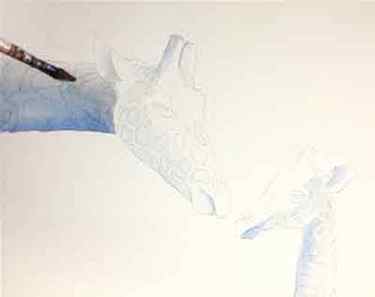
Wet the area you will be painting
Paint the light areas
- Define your light source. In this painting the light comes from the upper right.
Form your subject by painting light and dark sides.
Use several light layers of color. Let one layer dry before glazing on the next layer.
Glaze a layer of Burnt Sienna over the blue shadow areas to create a lovely brown.
Paint only orange closer to the light. Notice the top of the mother’s face was left white for a stronger highlight area.
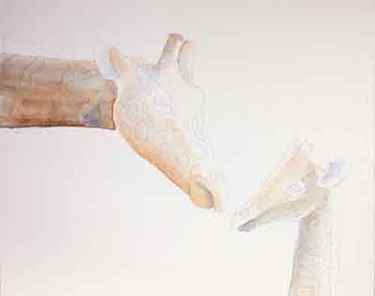
Paint the colors first
Paint the darks
Paint the dark spots over the underpainting. The darker colors will cover the lighter colors.
Adjust the color intensity with more or less water.
The dark spots on the mother’s neck are done with one layer of paint. Tube watercolors do not take several layers to get a dark color.
Premix blue and orange on your palette for the very dark brown of the eyes and other darks.
Paint both the mother and baby. Let them dry.
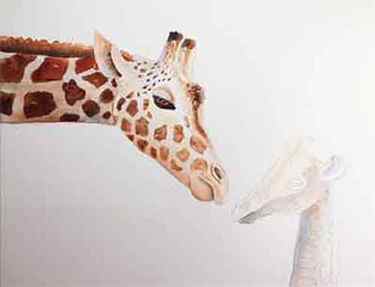
Paint the darks
Paint the background
Before you paint, wet the painting area. Paint before the sheen goes away, so the paint will flow.
Use a large round brush and work quickly to prevent hard edges.
Flick some dark blue spots on for added interest. My idea was to repeat the pattern of giraffe spots.
You may paint a background without spots, which would be great.
How you paint a giraffe is your individual choice as the artist.
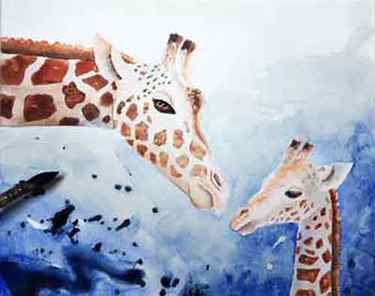
Paint the background
- Please Note: Some people like to paint the background before the subject. If the subject is painted first, it is easier to see how to contrast the values.
When you paint a giraffe it’s a matter of preference, either way is correct.
Detail and finish the painting
Look over your painting for any touches.
Check your values. Make sure you have used light and dark values to define the giraffes.
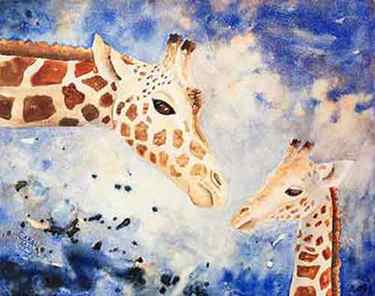
Detail and finish the painting
In the background I painted and flicked in some orange areas to help tie the subject and background together.
Later I removed a bit of the orange in the background because it competed with the giraffes. It’s a matter of choice, put what looks good to you.
After the paint was dry, I scratched out the highlight on the mother’s eye and touched it with a bit of orange.
a colorful, fun giraffe painting
- Paint a giraffe with your own selection of colors. Choose 3-5 colors that suit your own taste!
This painting was done with New Gamboge, Opera Pink, Dioxazine Purple and Thalo Blue.
draw your giraffe
Draw the giraffe on a separate paper. Transfer the drawing to your painting surface.
Draw directly on your painting surface if you are good at drawing.
Erasing on the painting surface may cause damage. A damaged surface may restrict the free flow of paint necessary for this technique.
This painting was done on an 11×14 Aquabord.
Use masking fluid and m ask a highlight for each eye and let it dry.
Wet your painting surface with a large brush.
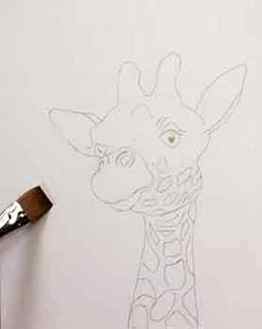
Put your drawing on the painting surface
Put colors on the wet surface
Brush on 3-5 colors while the surface is still wet. On a large painting you may pour the watercolors.
The colors will flow and mingle together. See how the yellow and pink mixed to create orange.
Some of the purple flowed into green and made mud. I blotted the mud with a paper towel. And replaced it with some pink (See in the next image).
Spritz the outside edges of the colors, so they blend softly onto the white.
If you want some white around your colorful giraffe, leave dry areas and the paint won’t flow there.
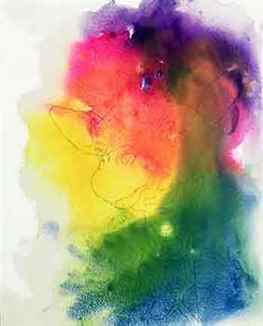
Put colors on the wet surface
Retrieve your drawing
- Let the paint dry thoroughly. The colors dry a little lighter than the wet paint.
Lift the dried paint off the edges of the giraffe. The beauty of using Aquabord is that the colors will lift.
Lift the dry paint with a damp stiff brush, a fiberglass brush or the eraser on a #2 pencil. The pencil eraser is what I used for most of the lifting.
Make sure you can see the entire drawing by darkening the drawing with a #2 pencil.
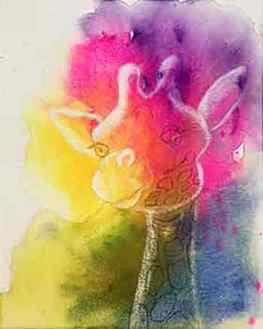
Retrieve your drawing
Paint the darks and highlights
Glaze more yellow for the light side of the giraffe and blue or purple for the shadow side. Look at the giraffe’s neck for example, yellow on the left side and blue for the shadow side.
After the glazes are dry, paint t he spots with purple.
Complete the rest of the painting in a similar manner, yellow for the lights and purple for the shadows.
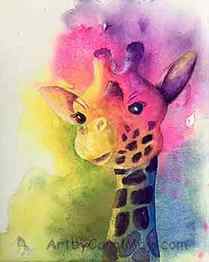
Paint the darks and highlights
Green was added to the left of the giraffe to pull it away from the background .
After the paint is dry remove the masking fluid to reveal the highlights in the eyes.
Lots of fun – you can paint a giraffe!
a quick, easy giraffe painting
- Paint a giraffe to get a point across.
Paint the main subject
Paint a giraffe that is quick and easy on heavy #300 watercolor paper that does not require stretching.
Burnt Sienna and Ultramarine Blue are my favorite pair of paint mixing colors. Use more Sienna to make a warm brown and more Ultramarine for a cooler brown.
- Use plenty of paint and paint on dry paper.
Use clean water to disperse and soften the color. Example, paint dark in the ear’s shadow. Then quickly use water to pull the paint to the edge.
The giraffe’s dark spots were painted quickly before the lighter underpainting was dry. Then the spots blend into the damp underpainting with soft edges.
Paint around the highlights in the eyes.
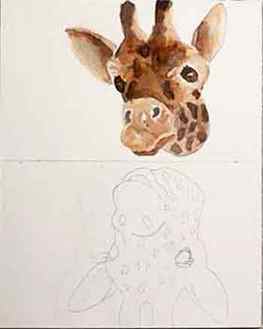
Paint the main subject
Paint the reflected giraffe
Turn the painting upside down and paint the second giraffe. I learned from previous paintings that I need to paint reflections right-side-up. My mind doesn’t like painting upside-down.
This happy giraffe is done in brighter, cheerier colors. And it has a smile on its face.
Don’t see yourself weighed down by the cares of the world. Instead see yourself beautiful the way God sees you.
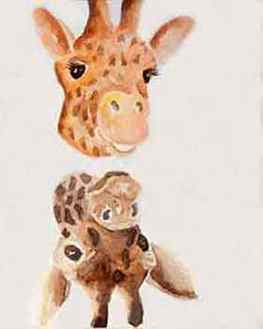
Paint the reflected giraffe
Paint the background
After the giraffes are painted and dry, paint the background.
There is blue water around the reflected giraffe and dirt around the unhappy giraffe.
When I do close-up subjects like these giraffes, I paint the background after the main subject. It gives me the opportunity to co-ordinate the colors and values against the main subject.
When I paint landscapes, I do the opposite. First I paint the background and then come forward and paint the focal point.
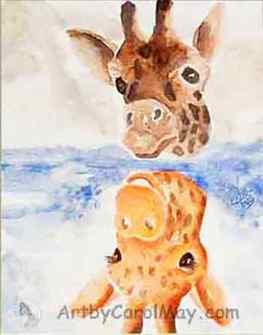
Paint the background





